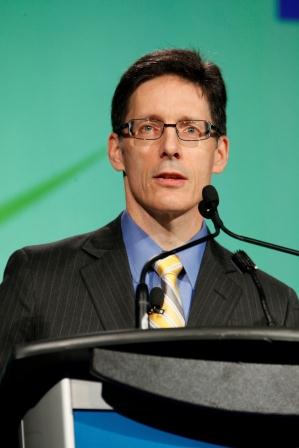
TORONTO – Telus and Rogers Communications may disagree on many things. But they both strongly favor a national consumer protection code for the telecom industry.
Echoing the call by Rogers communications divisional president Rob Bruce on Monday, Robert McFarlane, executive vice president and CFO of Telus, urged the federal government to adopt a national regulatory standard for protecting mobile phone customers. In Tuesday’s opening keynote at the Canadian Telecom Summit here, McFarlane argued that the country needs a single national code rather than “a patchwork of provincial rules” covering wireless contracts and services.
“It has been 20 years since a national telecom system was codified in law and now is not the time to unwind that,” he said. “Instead, a streamlined and centralized approach for customer protection will reduce costs and enhance efficiency and effectiveness.”
Citing “spectrum capacity challenges,” McFarlane also called on the feds to move faster to put new wireless spectrum on the market. Specifically, he urged Ottawa to conduct the still pending 700 MHz and 2.5 GHz auctions as soon as possible.
Along similar lines, McFarlane said the wireless industry needs government help to foster the building of more cell towers and offer greater mobile capacity. Decrying “the politics of tower construction” for limiting political support for tower development, he suggested that Canada follow the lead of the U.S., where the FCC has championed the need for more towers. “We encourage government to work in partnership with industry to ensure networks get built and meet customer demand,” he said.
Taking issue with Bruce on the domestic roaming issue, however, McFarlane (right) denounced Industry Canada’s proposal to allow all carriers to use the others’ networks for roaming at mutually agreed-upon commercial rates. He contended that “an over-reliance on roaming and asymmetrical build obligations may reduce rural deployment and leave spectrum unused.” He urged the government to set “tighter minimum build requirements for all carriers to preclude spectrum hording and speculation” and “review all carrier roaming on a regular basis to ensure spectrum is really being deployed.”

Still unhappy about the federal government’s recent loosening of foreign ownership rules for new, smaller wireless providers with less than 10% market share, McFarlane called on Ottawa to lift the restrictions for all carriers regardless of size under a proposed “second phase” of liberalization. He argued that the new 10% rule discriminates against established, larger domestic providers, keeping them from tapping into fresh capital while enabling smaller players to gain funding from international companies much larger than Telus, Rogers or Bell Canada.
“You have to be very careful when you’re managing industry structures that you create a level playing field,” he said, warning against the “unintended consequences” of such policies. “If you’re going to liberalize for some, then liberalize for all.”
Finally, McFarlane took a shot at moves by Rogers and Bell to scoop up broadcasting and cable network properties over the past few years. Criticizing such “vertical integration” maneuvers, he argued that these “benefits of scale” should “not come at the expense of consumer choice.” He noted that Telus’ budding IPTV initiative, known as Optik TV, has become an early “success story” by offering both more advanced services and greater choice to consumers. Now in 550,000 Canadian homes, Optik TV has been adding about 40,000 to 50,000 subscribers per quarter, more than any other multi-channel video service.
“If more choice is not enabled, more and more Canadians may cut the cord,” he said. “Canada may already be the most vertically integrated market in the OECD, so we need timely enforcement of safeguards to maintain choice and diversity.”
Photo by Pinpoint National Photography



